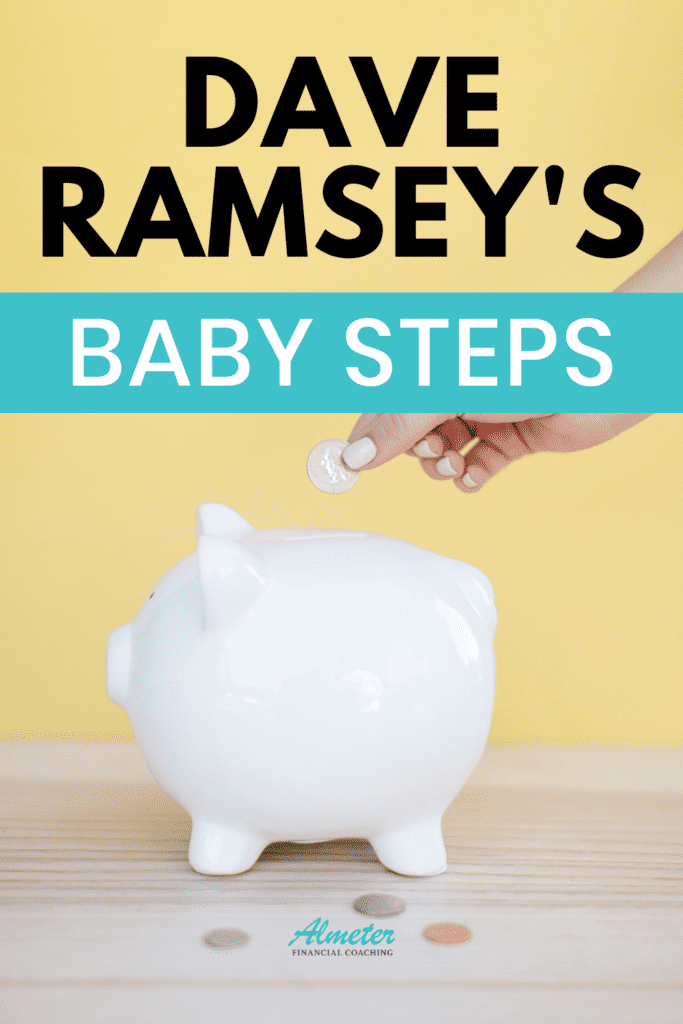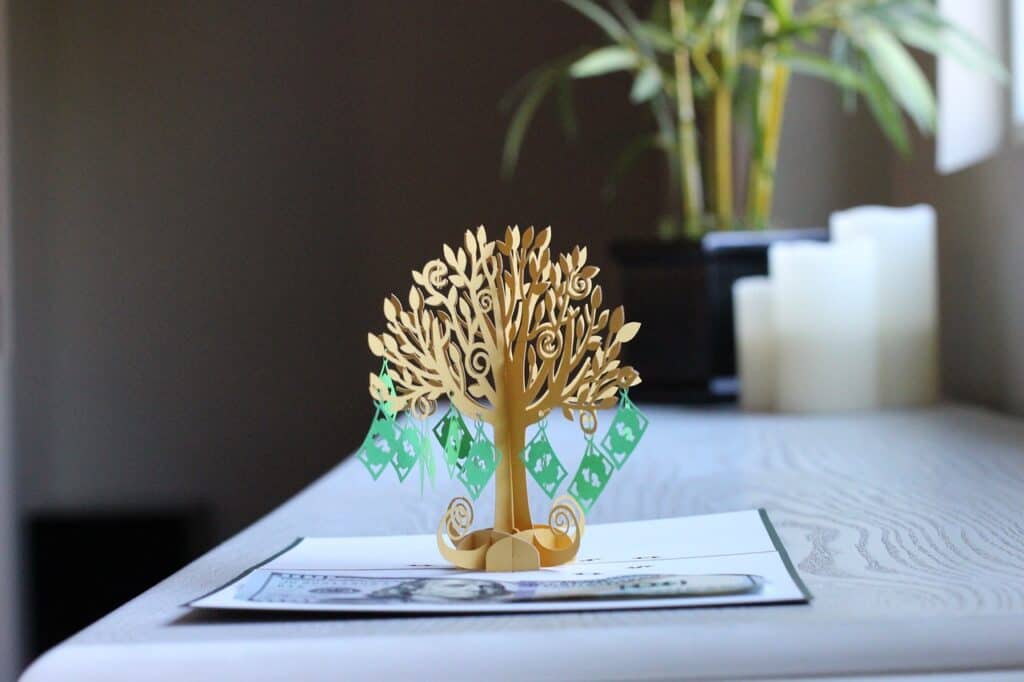The Dave Ramsey Baby Steps will give you the roadmap to financial peace!
This post contains affiliate links. As an Amazon Associate I may earn from qualifying purchases at no additional costs to you. Please see the Policies pages for more info. Updated on 6/24/2023
Have you ever wondered what life would be like if you didn’t have any debt payments, had some money in the bank, and were building a healthy retirement fund? That is all possible with the Dave Ramsey Baby Steps to Financial Peace!
In this post I will briefly go over each of the baby steps that have guided us with making money decisions.
What are Dave Ramsey Baby Steps?
The 7 baby steps to financial peace were developed by financial guru, Dave Ramsey. Dave came up with the baby steps after he went into bankruptcy and wanted to learn God’s way of handling money. These steps helped him get out of bankruptcy and build wealth. Dave has helped millions of families change their financial situation over the last 30 plus year following these same principles.
We first learned about the baby steps in 2012 when we took Dave Ramsey’s Financial Peace University (FPU) with a group of people from our church. I had always considered myself pretty “good” with money but there was still a lot we learned.
Applying the baby steps has drastically changed how we handle money. The biggest impact has been paying off our student loans early.
How Dave Ramsey’s Baby Steps Work
Baby Steps 1 through 3 are meant to go in order – finishing one step before you go onto the next. This is how you make the most progress in one area so you’re not splitting your resources between building an emergency fund and paying off debt.
Baby Steps 4 – 6 are done in order but at the same time. That probably sounds a little confusing. Basically you will have these steps set up on autopilot but you will be actively working towards them at the same time. This should make more sense once to you know the baby steps.
Baby Step 1 – $1,000 in Emergency Fund
Before you can tackle debt and start saving aggressively for college or retirement, you must be able to handle unexpected expenses without going into debt further (using your credit card). Car repairs, broken furnace, medical bills – life happens and you will feel much better about these situations if you have the cash on hand to cover them.
So the first step is to save $1,000 into an emergency fund as quickly as possible.
Now you’re probably wondering, “just $1,000?”
Yes, just $1,000 for now to have a little cushion for some unplanned expenses. It’s not meant to be a lot because you want to save this up quickly (within 30 days is average) so you can start tackling debts in baby step 2.
Baby Step 2 – Pay Off Consumer Debt Using the Debt Snowball
Once you have established your starter emergency fund it is time to tackle small debts!
These are all your debts excluding your mortgage. They include credit cards, car loans, student loans and personal loans.
The best way to do this is to use the debt snowball method. With the debt snowball you list each debt balance from smallest to largest. Then you put any extra money you have each month towards paying down the smallest debt first, while paying the minimum balances on the other debts.
Once your first debt is paid off you will put that payment towards your second smallest debt until it’s paid off. Continue to do so once all debts are paid off.
I explain this in more detail in How to Use the Debt Snowball to Pay Off Debt Faster.
Baby Step 3 – 3-6 Months of Expenses in Savings
Now that all your small debts are paid off (yay!), it’s time to increase your Emergency Fund to 3 to 6 months worth of expenses.
This provides your safety net if you were likely to lose your job or have medical issues that prevented you from working for awhile. To calculate how much you will need, add all your monthly household expenses and multiply it by how many months you would like to build up your fund for.
This doesn’t mean 3 to 6 months of income – just your essential expenses.

Baby Step 4 – Invest 15% of Income for Retirement
Baby step 4 is where you can start to breath a little!
Your consumer debt is paid off and you have a fully funded emergency fund.
Now it’s time to set yourself up for retirement! You will likely already be contributing to your retirement funds if your company has a 401(k) program but now you can really kick it up! Invest 15% of the household income into retirement funds.
Dave actually recommends that you stop all retirement investing while you’re in Baby Steps 1 through 3. This will give you more cash to get through the first few baby steps. Personally we didn’t do this but if you need extra cash at first this is where you can find it.
(Please note that I did not say “withdraw” from retirement. That is a different story. I don’t recommend that because of the penalties. Just put a pause on contributing your your account.)
Don’t forget to diversify! Split your 15% between 401(k), Roth IRA, Traditional IRA and Mutual Funds. A financial advisory can help you make these decisions.
Baby Step 5 – College Funds for the Kids
With small debts paid off, emergency fund in place and retirement fund building, it’s time to start saving up for the kids’ college (if you have them).
Anything you can save will help them in the end so your children can avoid going into debt with student loans.
Look into 2 different college savings plans; 529 College Savings Funds or Coverdell Education Savings Account (ESA). Each state will have different stipulations so do some research on all of your options.
Baby Step 6 – Pay off Mortgage Early
So close to being completely debt free! Now it’s time to tackle the mortgage!
With any extra money you have (like the money you are no longer putting into other debt), apply it to extra payments on the principle of your mortgage. Paying off your mortgage early will save you thousands of dollars in interest in the long run.
Plus, how would you feel if you didn’t have to pay your mortgage every month? What could you use that money for? That brings us to the last step.
Baby Step 7 – Build Wealth and Give
This is the fun part of the Dave Ramsey baby steps!
You are completely debt free, have a comfortable savings set aside for emergencies, college tuition for the kids and a retirement plan in place. Now you should have some extra money in the budget to build wealth and give!
Travel, donate to your favorite charities, help others in need, whatever makes your heart happy! This is financial freedom!
The Foundation to Success with the Baby Steps
You can’t do any of this unless you know where your money is going.
That’s why you have to create and follow a written zero-based budget each month! As Dave Ramsey says, “a budget tells you where your money is going, instead of wondering where it went.”
Related Articles to help you with the Dave Ramsey Baby Steps:
- Make a Budget: 5 Simple Steps to Get Started
- How to Quickly Save $1,000 for an Emergency Fund
- How to Use the Debt Snowball to Pay Off Debt Faster
- What is a 529 College Savings Plan?


